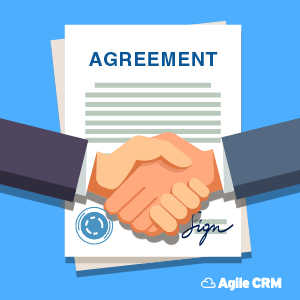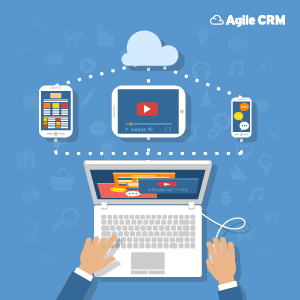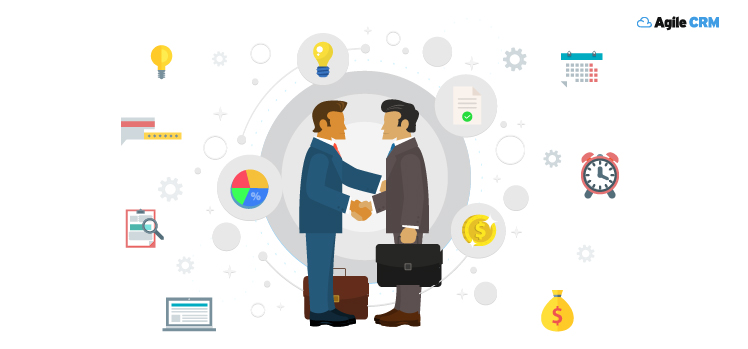How to leverage a simple service level agreement: The basics
A simple service level agreement (SLA) is a contract between your company and your customers. It defines parameters around certain services that you provide, giving your customers a concrete understanding of what they can expect from you. They can be used in a number of circumstances, and we’ll dig into that below. But first, we’ll cover some basics, key elements of SLAs, and the benefits involved in implementing them.
What is a simple service level agreement?

A simple service level agreement defines variables around the service you provide to your customers—such as customer support. However, they can also be used internally, such as to define the amount of time in which your sales reps are expected to follow up on newly qualified leads. Here are some basic parameters that you can define with a simple service level agreement:
Describing the service being provided

If you are using SLAs to define the customer support you provide, you can lay out the basic tenants of that support. For example, you can specify that customer support will always be available to your paying customers. Regardless of what your service is, you should take the time to think about your customers’ needs, and what will ensure their satisfaction with your service. This will allow you to create a simple service level agreement that is solid and trusted by your customers.
Time to respond

Again, if you are using SLAs to define your customer support services, you could use a simple service level agreement to stipulate that any incoming help desk support ticket will be responded to within a maximum of 24 hours, for example. Or that an open ticket will be resolved within X amount of days.
You can also use SLAs to tell sales reps they must reach out to newly qualified leads within a certain time frame. This keeps them focused on the prize, as SLAs are tracked in your contact management system and sales managers can see when they are not being met by your reps.
Exception clauses

There may be certain circumstances in which your simple service level agreement does not apply. For example, if there is a natural disaster that prevents your customer support team from being able to work for a few days, your exception clause could cover that. In that case, you would not be held accountable to the contract you have around response times.
Availability of SaaS accessibility

If you run a software as a service (SaaS) company, you know that there are times when your servers may go down. When that happens, your application might not be available to customers for a small amount of time. That is a normal and inevitable occurrence. However, your customers need to be assured that your application will be there for them most of the time.
When your server goes down, it is referred to “downtime.” Equally, when your server is up and running normally, it is called “uptime.” You obviously want to aim for 100% uptime, but things happen unexpectedly and it’s probable that you will have at least a little downtime in each year you provide service.
You can use SLAs to promise 95% or 98% uptime on a yearly basis, for example, to assure your customers that they can rely on your service. Learn more about uptime and downtime standards.
Penalties for not meeting SLAs

Just as you need to tell customers what they can expect from your service, you also need to define what happens when you don’t meet your SLA.
Let’s say your customer support team breaks their SLA by leaving a customer support ticket without a response for too long. What happens then? Do you give the customer some credit for future service?
You need to define some kind of reimbursement for not meeting your SLA, otherwise there’s really no point in having them in the first place.
SLA monitoring and reporting

Once your SLAs are in place, who will monitor them and be alerted when they are broken? If you use an all-in-one CRM, like Agile CRM, all of the data around your SLAs is tracked in the system and easily accessible. You can run daily, weekly, or monthly reports to see which SLAs are not being met. This gives you an at-a-glance view into where things are going wrong so you can fix them as quickly as possible.
We advise running these reports daily, as you don’t want to wait a week to find out that something went wrong. You’ll end up with unsatisfied customers, customer loyalty will drop, and your business will suffer. This is why SLA monitoring is so critical to customer satisfaction.
Benefits of simple service level agreements
Above we mentioned a few of the benefits of SLAs. Here, we will dig into the nitty gritty of how your business can benefit from leveraging them.
Improved customer satisfaction

Customer satisfaction is an incredibly important, but often elusive element of a successful business model. Often, companies focus too heavily on acquiring new customers, and too little on satisfying and retaining existing ones. This can be quite damaging to sustainable business success, both for small business and enterprise companies alike.
Providing solid, clearly-defined SLAs helps improve customer satisfaction by telling customers that you are committing to ensuring their success. Not only that, you are binding yourself to reimburse them if you don’t meet their expectations.
IT service level agreements and other types of SLAs enable you to provide a world-class customer experience. And, according to Walker Info, by 2020, the customer experience will replace price and product as the key brand differentiator. Now is the time to start thinking about how you can define your services through service level agreements, in order to deliver and maintain world-class customer satisfaction levels.
Clearly defined processes

Without SLAs in place, you are likely to face issues where employees are not sticking to defined processes. One customer support rep might like to do things his way, while another prefers to do things her way.
You can’t have your reps running renegade in every direction doing things their own way. You need established procedures that they are expected to follow. Putting SLAs in place aligns your team around the same processes and ensures that the customer experience is consistent every time.
Leaves no room for doubt

SLAs reduce confusion among both your reps and your customers. They provide each of them with a set of guidelines—a roadmap, if you will—that they can follow without any confusion or misunderstanding on either side. It is the final word and allows customers to know exactly what to expect.
SLAs also provide your reps with a clear understanding of what is expected of them. This makes life easier on your reps, as it minimizes situations in which they don’t know how to react in a given scenario. SLAs set out clear guidelines and a path to completing them.
Improves first call resolution rate

First call resolution refers to your ability to resolve a customer issue on the first try. It means not having to go back and forth with a customer multiple times to resolve their issue. It is a giant headache for a customer to call support, then have to wait days for an issue to be resolved.
Tickets often get bounced around to different reps while the support team tries to find the right person to resolve the issue. Having to adhere to a simple service level agreement makes your team more aware of response times and pushes them to resolve issues on the first attempt.
This is made even easier when you can leverage dedicated support groups. The more diverse your company and its product offerings are, the more diverse your customer support team must be. Dedicated support groups allow you to segment out groups of customers and the associated support reps that support them into silos.
This means that when a customer calls in that uses a certain product, you can automatically route them to the reps that are best equipped to support them. This is easily done with system tags that let you label contacts based on various attributes, like product used, language spoken, etc.
Increases transparency

A simple service level agreement lets you track where certain guidelines are being broken. With customer support analytics, all of that analysis is automated. This allows you to focus on higher-value work and simply check in on your dashboard to see where SLAs are not being met.
The ability to maintain insight into SLAs and their outcomes provides a great amount of transparency to a company’s ability to consistently meet SLAs. When they are not being met, you can see where and why, allowing you to engage in an exercise of constant performance improvement.
Improves support performance

This one kind of goes without saying, but when your reps have strict contracts that they must adhere to, they will be much more self-aware of the quality of their output. This is especially true when there are penalties involved in breaking SLAs.
In addition to penalties that force your company to reimburse customers for breaking SLAs, you can also implement penalties for employees who break them. You don’t want to be draconian when penalizing your employees. You just want to provide a nudge that motivates them to hit their SLAs every time.
Form them in a way that encourages staffers to meet SLAs, and even consider rewarding them when they go X amount of time without breaking one. This approach has been shown to motivate reps to work harder, and continually improve the support they provide.
Can differentiate you from the competition
Let’s use an example to explain this benefit. Let’s say you have a competitor called Company X. Company X provides their service at a slightly lower price than you do, meaning that many consumers look to them first. However, despite the difference in price point, Company X is not willing to sign an SLA that defines the parameters around the service they provide.
On the other hand, you do provide SLAs, which gives potential customers peace of mind knowing that if something goes wrong, you have committed—by contract—to resolve the issue. This makes you a more reliable business in the mind of the consumer. It also can help to build brand loyalty and extend your brand awareness.
Conclusion
Service level agreements provide clarity for both your team and your customers. They lay out the processes that define what kind of service you provide, which helps your team stay on track and provide a consistently positive customer experience. They also provide assurance to your customers around what they can expect from you in various situations.
As mentioned above, a simple service level agreement is a highly effective way of increasing and maintaining high levels of customer satisfaction. Satisfied customers purchase more, recommend your brand to their friends and colleagues, stick around longer, and are more loyal to your brand. In short, SLAs can reduce customer churn while raising satisfaction levels. This is incredibly important when you consider the following statistics:
- It costs five times more to acquire a new customer than to retain an existing one. (Source: Invesp)
- Existing customers will spend 67% more on a given company than new ones. (Source: Business.com)
- 80% of a company’s future revenue will come from just 20% of its existing customers. (Source: Gartner Group)
- Increasing customer retention rates by just 5% will increase profits by anywhere from 25% to 95%. (Source: Bain & Company)
SLAs lend credibility to your brand and the service you provide. They formalize expectations around the service you deliver, which makes life easier on everyone involved. By following the basic steps mentioned above, you will be able to accomplish all of that and more. Plus, you will reap all the benefits discussed above, allowing you to elevate your customer support presence from ordinary to exceptional. If you are not using SLAs today, now is the time to start.
Are you using SLAs? Do you have any anecdotes that will help your peers better implement and maintain compliance with their SLAs? If so, please share with us in the comments section below!


No Comments